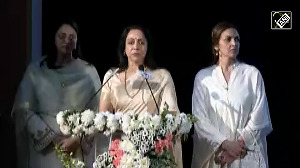 New Delhi’s growing defence partnership with Tokyo could take wing with the US-2 (Utility Seaplane Mark 2), a one-of-a-kind amphibious aircraft that has Indian naval planners goggle-eyed.
New Delhi’s growing defence partnership with Tokyo could take wing with the US-2 (Utility Seaplane Mark 2), a one-of-a-kind amphibious aircraft that has Indian naval planners goggle-eyed.
The mammoth 47-tonne aircraft, carrying 18 tonnes of load, can take off from, or land on, a 300-metre stretch of water or land, its four giant engines needing just seven seconds to get airborne. With a range of over 4,500 km, it can patrol areas 1,800 km away, and react to an emergency by landing 30 armed troops, even in 10-foot waves. Like the C-17 Globemaster III, which lands vast payloads on high altitude dirt runways, the US-2 attracts the Indian military for the unprecedented options it provides.
India and Japan have discussed a US-2 sale since 2011, when the Indian Navy sent several companies a Request for Information (RFI) about amphibious aircraft. Only ShinMaywa Industries offered capabilities that the navy wants for patrolling island territories like the Andaman and Nicobar chain, which is 1,200 km from Chennai and hundreds of km long; or for flying out spares and technicians to disabled warships out in the Indian Ocean.
Business Standard understands New Delhi and Tokyo are discussing signing an Inter-Governmental Agreement (IGA) to cooperate on the US-2, similar to the IGA between New Delhi and Moscow to co-develop a fifth generation fighter. An IGA recognises the strategic importance of a procurement programme, and takes it out of the purview of the restrictive Defence Procurement Procedure (DPP).
When Prime Minister Manmohan Singh visited Tokyo last May, the joint declaration issued after his meeting with Japanese Prime Minister Shinzo Abe noted: “They decided to establish a Joint Working Group (JWG) to explore modality (sic) for the cooperation on the US-2 amphibian aircraft.”
Interestingly, the JWG is not headed on the Indian side by a ministry of defence (MoD) official, but by Department of Industrial Policy and Promotion secretary. This suggests a perspective larger than merely a defence acquisition, with the programme, including industrial partnership, capacity building and finance, in addition to issues like certification, flight-testing, training, etc.
Defence cooperation between New Delhi and Tokyo has been growing, in tandem with apprehensions about an assertive China. Japan’s National Security Strategy, which was published on December 17, 2013, and a follow up document -- the National Defense Programme Guidelines (NDPG) --mandate increased cooperation with India. The NDPG states, “Japan will strengthen its relationship with India in a broad range of fields, including maritime security, through joint training and exercises as well as joint implementation of international peace cooperation activities.”
There are a mere seven US-2 in service worldwide, all in a “search and rescue” role with the Japanese Maritime Self Defense Force (JMSDS), as the Japanese navy is termed. Some 20 countries want to buy the US-2, but Article 9 of Japan’s Constitution holds it back from warlike activities, including the export of military equipment. In 2011, Japan’s cabinet issued a waiver, citing the strategic partnership, to allow the US-2 to be supplied to India. The utility of the US-2 in “benign constabulary missions”, such as anti-smuggling and anti-poaching, allows it to be passed off as a non-military aircraft.
With Japan self-limiting defence spending to under one per cent of the gross domestic product, Tokyo regards India’s military as a partner for achieving economies of scale in defence production. Japan’s National Security Strategy, published on December 17, 2013, notes that “it has become mainstream to participate in international joint development and production projects in order to improve the performance of defense equipment, while dealing with the rising costs… the Government of Japan will set out clear principles on the overseas transfer of arms and military technology, which fit the new security environment.”
After only five Japanese prime ministerial visits to India in half a century, the Indo-Japan strategic relationship was kick-started in 2000 with the then prime minister Yoshiro Mori’s visit to New Delhi. In 2006, his nationalistic successor, Shinzo Abe, signed a Global and Strategic Partnership with India. The two prime ministers meet yearly, and a “two-plus-two” meeting brings together the defence and foreign ministers. Japan has a “Security Cooperation Agreement” with India, which it earlier had only with the US and Australia. In June 2012, the two navies conducted the first JIMEX (Japan-India Maritime Exercise) in the Sea of Japan, which was repeated last month in the Bay of Bengal.
Asia watcher Dan Twining, writing in Foreign Policy, sees Tokyo as the core of a coalition that prevents China from dominating East Asia, just as Great Britain prevented Napoleon and Hitler from dominating Europe in earlier centuries. That is why, says Twining, when Japan, Australia, US and India joint forces in the Malabar naval exercise in 2007, “Chinese analysts correctly identified the grouping as one that could stymie China’s ‘natural’ leadership of Asia.”
Image: A Japan Maritime Self-Defence Forces US-2 search-and-rescue amphibian plane, manufactured by ShinMaywa Industries Ltd.
Photograph: Reuters











